Examples
Here you’ll find a bunch of examples showing how to calculate Omega in different situations. They walk you through all the possible scenarios and show the matching paths on the flowchart.
Hopefully, these will help you feel more confident using this shiny new metric and really get how it works. All the contestant names and results are made up (sorry, John), but the event details are real — so feel free to fact-check me… unless I made a typo. Then let’s just agree to be kind. 😄
Example 1
To start, let’s circle back to our friend John from the Introduction and calculate his Omega scores across the three competitions he entered: Detonation, Bristol Swing Fiesta, and Midland Swing Open.
Here’s what we know about his performance at Detonation:
- Prelim: Yes, Yes, No (20 points)
- Semi: No, Yes, No (10 points)
Looking up this competition on scoring.dance, we can find the number of leaders in all three rounds, and the number of leader-judging judges - these numbers are shown in the flowchart below:
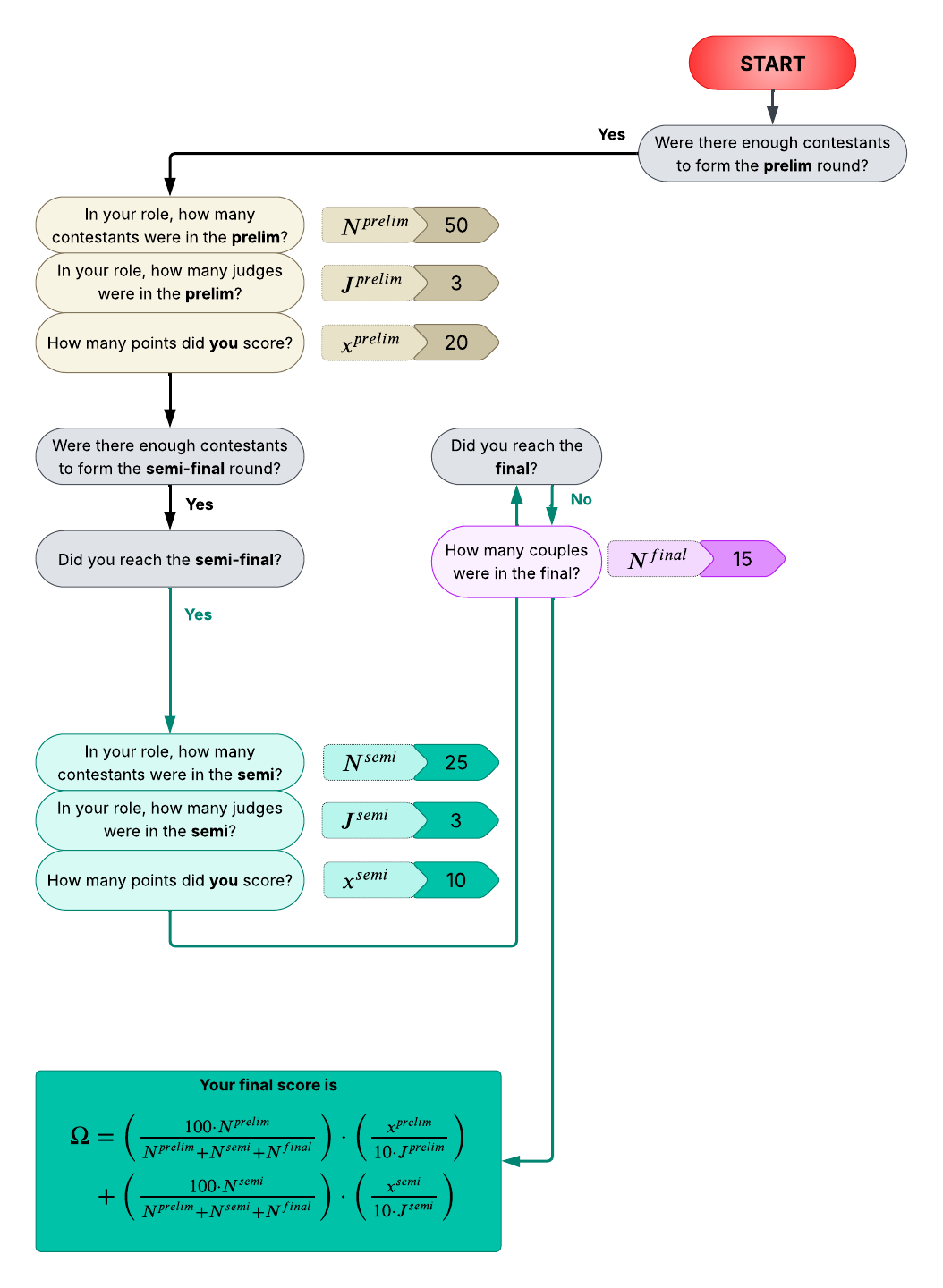
Plugging in the numbers we get:
\[\begin{align*} \Omega &=\Omega^{prelim}+\Omega^{semi}= \left(\frac{100\cdot 50}{50+25+15}\right)\cdot\left(\frac{20}{10\cdot 3}\right)+\left(\frac{100\cdot 25}{50+25+15}\right)\cdot\left(\frac{10}{10\cdot 3}\right)\approx46. \end{align*}\]
So John’s score at Detonation was 46 even though he didn’t reach the final!
You can make sense of the numbers - for example
\[\begin{align*} \frac{100\cdot 50}{50+25+15}&\approx 56,& \frac{100\cdot 25}{50+25+15}&\approx 28. \end{align*}\]
which kind of makes sense because only half of the contestant in the prelim round reached the semi round (and the components reflect that 56 / 2 = 28).
Similarly, because John scored 20 out of 30 points in the prelim round, he scored two thirds \(\left(\frac{20}{10\cdot 3}\right)\) of the points possible in this round.
Example 2
At Bristol Swing Fiesta, John did really well scoring:
- Prelim: Yes, Yes, Alt2 (24.3 points)
- Semi: Alt1, Yes, Alt1 (19 points)
- Final: 7th place (1 WSDC point).
Here, we used the WSDC Tier table to look up how many points are awarded for placing 7th. Once we’ve got that, we simply follow the appropriate path on the flowchart using the details from this specific competition. Let’s walk through it step by step:
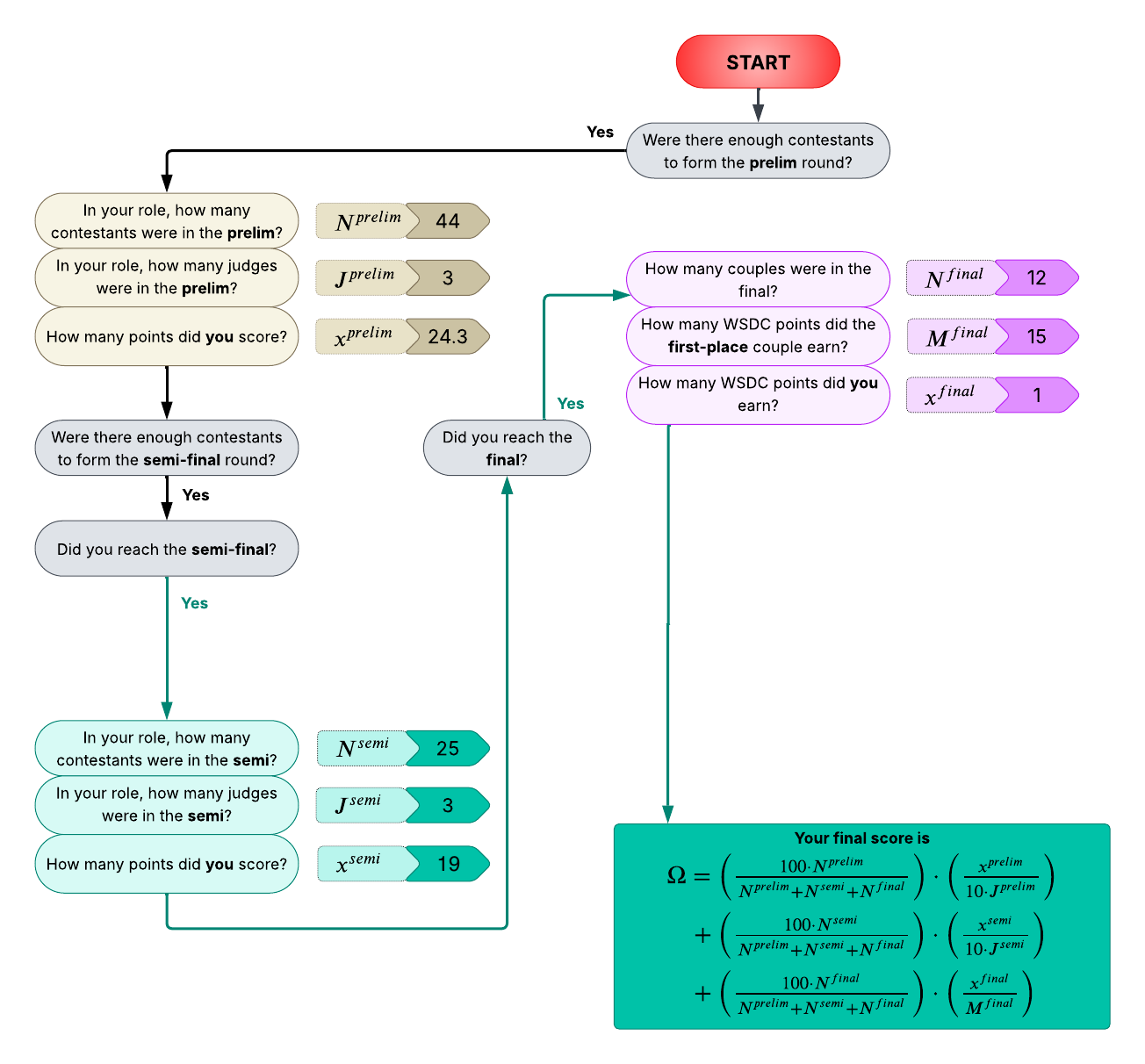
Plugging in the numbers we get
\[\begin{align*} \Omega &=\Omega^{prelim}+\Omega^{semi}+\Omega^{final}\\ &= \left(\frac{100\cdot 44}{44+25+12}\right)\cdot\left(\frac{24.3}{10\cdot 3}\right)+\left(\frac{100\cdot 25}{44+25+12}\right)\cdot\left(\frac{19}{10\cdot 3}\right)+\left(\frac{100\cdot 12}{44+25+12}\right)\cdot\left(\frac{1}{15}\right)\\ &\approx 65. \end{align*}\]
John did really well — no doubt about it! But he could’ve squeezed out a few more points in the prelim and semi rounds. Placing 7th and earning a WSDC point is definitely a win, but in this tier, that’s just 1 out of a possible 15 final-round points. So, overall? A solid performance — but not Omega-perfect.
Example 3
At Midland Swing Open, John got:
- Prelim: Alt2, No, Yes, Yes, Alt1 (28.8 points)
Let’s see how this translated to the Omega score:
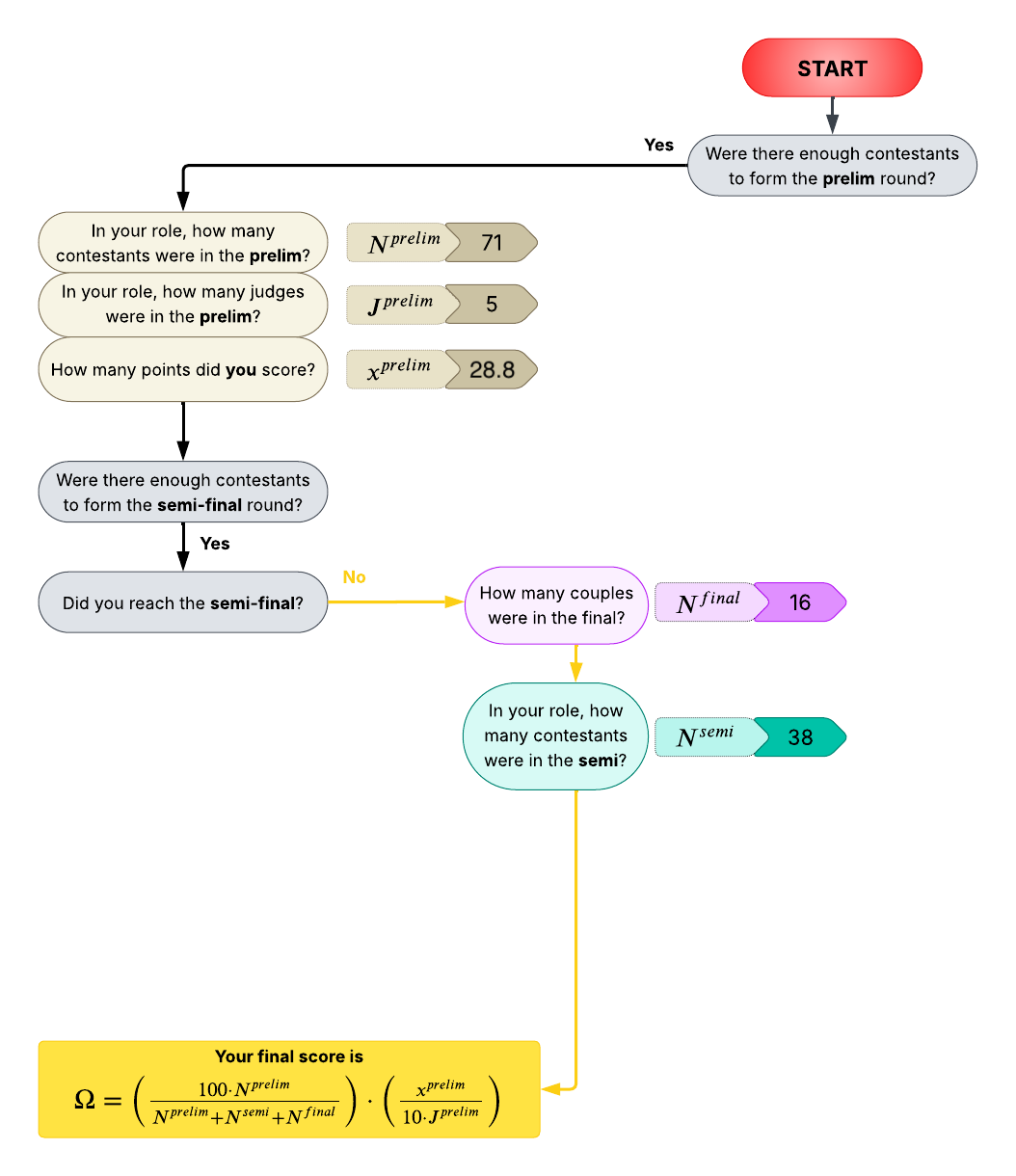
Plugging in the numbers we get
\[\begin{align*} \Omega &=\Omega^{prelim}= \left(\frac{100\cdot 71}{71+38+16}\right)\cdot\left(\frac{28.8}{10\cdot 5}\right)\approx 33. \end{align*}\]
Even though John didn’t make it to the semi-final this time, he still scored 33 points - not bad at all! (For reference, his raw judges’ marks only added up to 28.8.) Why the boost? It was a big comp, and doing well in a tough prelim earns you some serious respect - and points.
In fact, he walked away with nearly half as many points as he did at BSF, where he actually made the final! Most importantly, even without earning any WSDC points, John isn’t left empty-handed. The Omega score sees his effort - and rewards it. 💪
Example 4
Meet Mateo - an All-Star leader with some serious groove. Here’s how he did in the 2025 Nordic WCS Championships All-Star Jack & Jill:
- Prelim: No, Yes, Alt1, Yes (24.5 points)
- Final: 4th place (2 WSDC point).
Note that the competition wasn’t big enough to form the semi-final round, but it is not an issue for the Omega score! Following his path, we get:
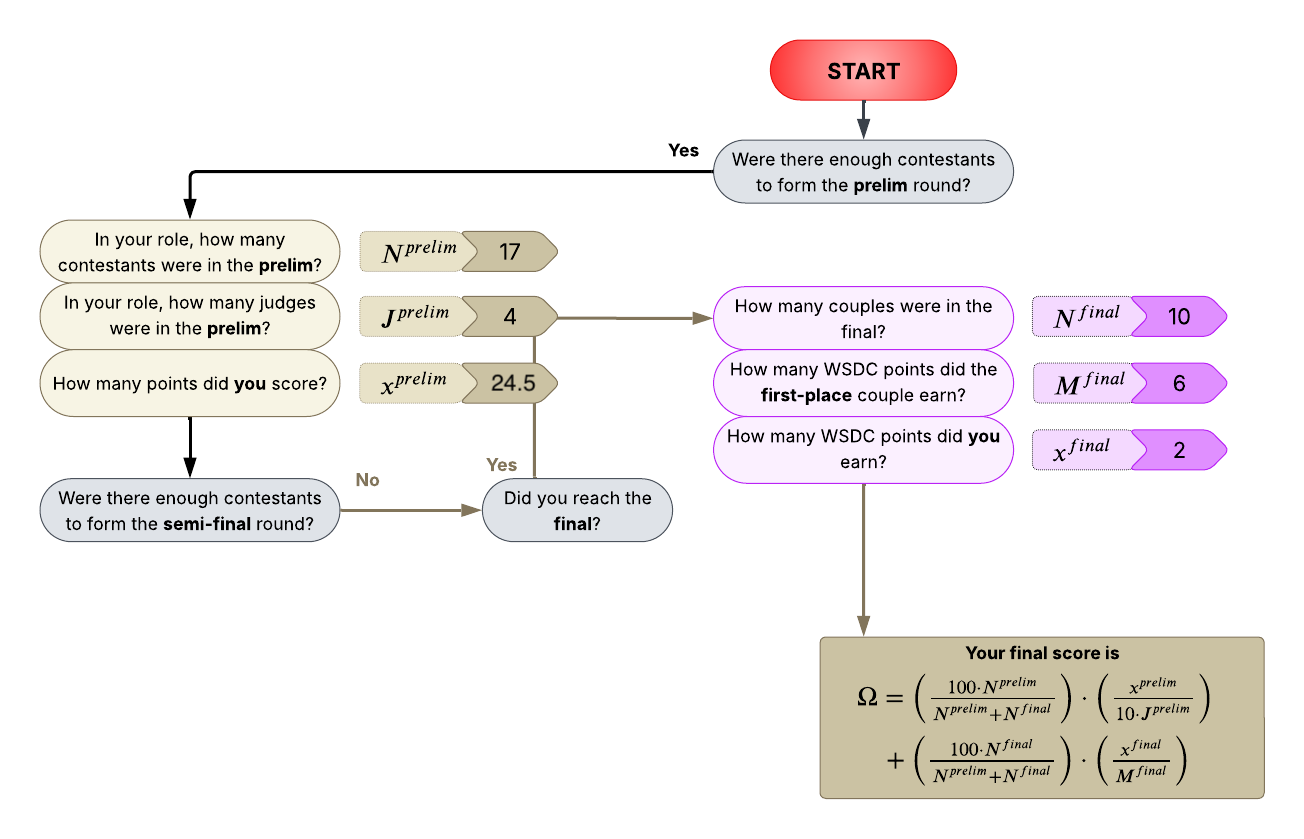
\[\begin{align*} \Omega =\Omega^{prelim}+\Omega^{final}= \left(\frac{100\cdot 17}{17+10}\right)\cdot\left(\frac{24.5}{10\cdot 4}\right)+\left(\frac{100\cdot 10}{17+10}\right)\cdot\left(\frac{2}{6}\right)\approx 51. \end{align*}\]
You might be thinking, “Wait, that score feels a bit low — didn’t Mateo make the final?” 🤔
Fair point! But remember, Omega doesn’t just reward making the final - it also reflects how well you did in the non-final rounds. And while Mateo didn’t bomb prelims, he didn’t exactly crush them either - scoring 25 out of a possible 40 points. Combine that with a 4th place finish in a small WSDC Tier comp, and voilà — that’s the Omega score you get. It’s not bad… just honest.
Example 5
Say hi to Marta - a Newcomer follower who competed in Westie Gala 2024/2025 Newcomer Jack & Jill. Again, the competition was too small to form the semi-final round. She did her best but was only 0.1 points away from making it to the final round. She was marked:
- Prelim: No, Yes, No, Alt3 (14.2 points)
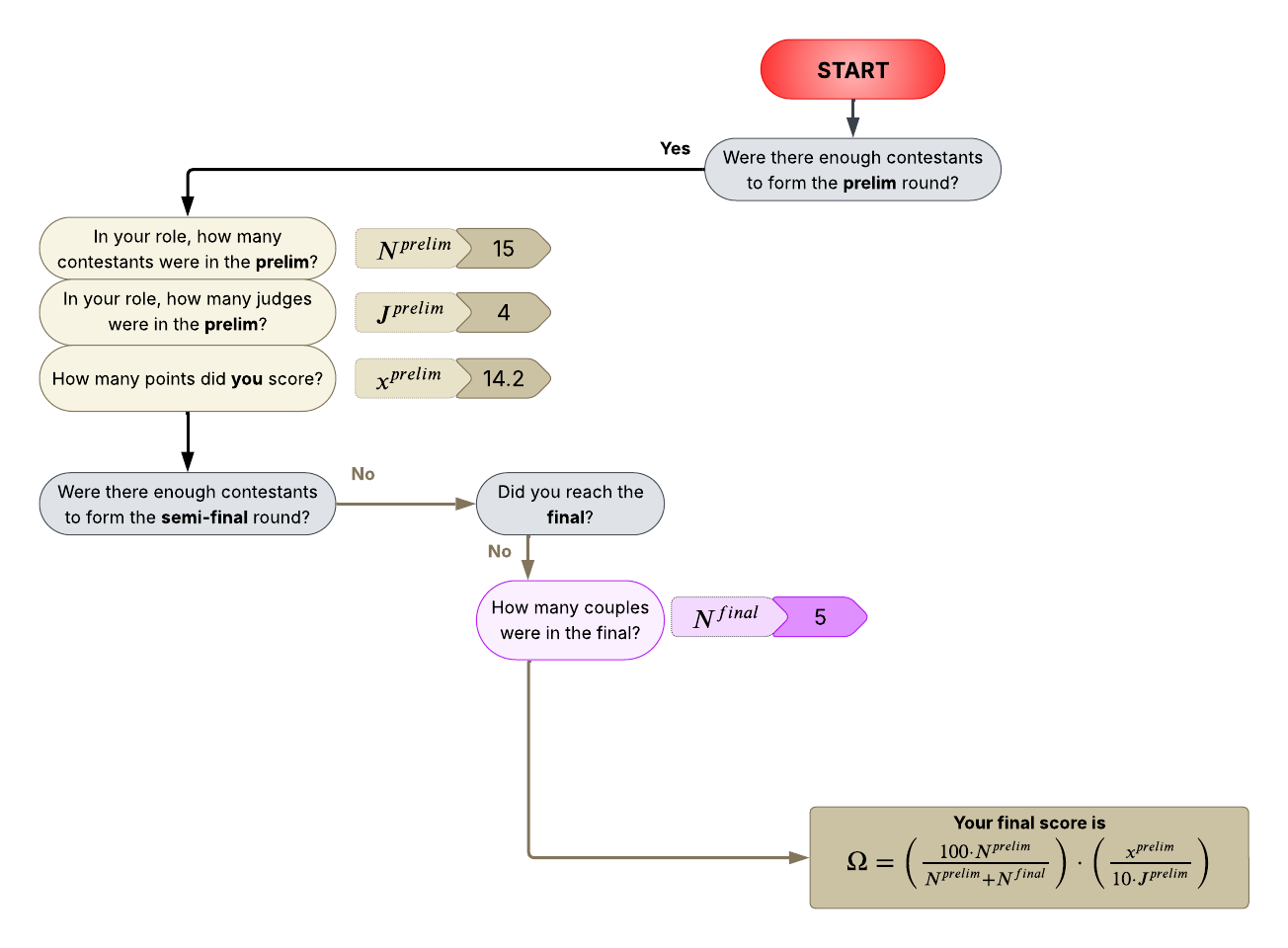
Plugging in the numbers we get
\[\begin{align*} \Omega =\Omega^{prelim}= \left(\frac{100\cdot 15}{15+5}\right)\cdot\left(\frac{14.2}{10\cdot 4}\right)\approx 27. \end{align*}\]
This is still a sizeable chunk because only 5 followers made it to the final, making the prelim round fairly difficult!
Example 6
Christa is a Advanced follower who competed in Strictly Open at Dutch Open 2025, where there were only a few All-Stars competitors, all of whom competed in the final round straight away. She and her leader placed 2nd! What’s her final Omega score?
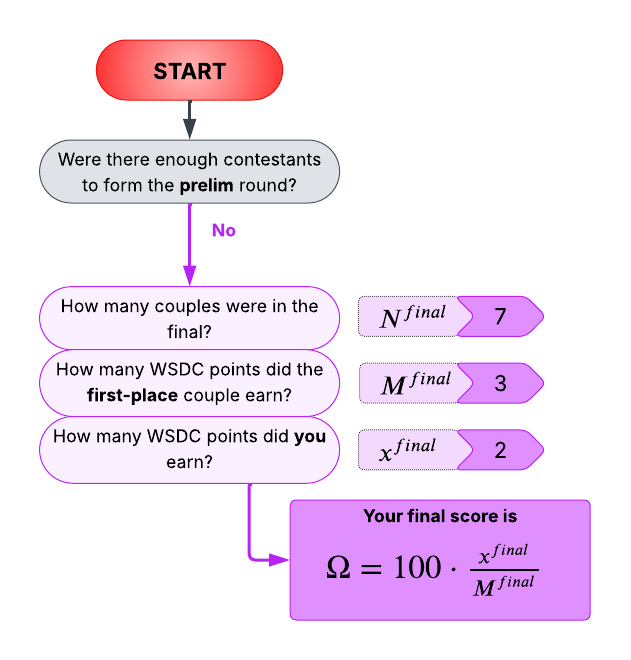
\[\begin{align*} \Omega =\Omega^{final}= 100\cdot\frac{2}{3}\approx 67. \end{align*}\]
In this case, the highest WSDC score awarded was 3 points. Scoring 2 points puts you nicely between them, and earns you an Omega of 67 - right where it should be, especially since there were no prelim or semi rounds to factor in. Simple, clean, and math-approved!
Example 7 (Quarter-Final)
It’s not shown directly on the flowchart, but the Omega score can easily be extended to handle competitions big enough to include a quarter-final (a rare but exciting case!). Just add an extra component, \(\Omega^{quarter}\), into the mix.
\[\begin{align*} \Omega &=\Omega^{prelim}+\Omega^{quarter}+\Omega^{semi}+\Omega^{final}\\ &=\left(\frac{100\cdot N^{prelim}}{N^{prelim} +N^{quarter}+N^{semi}+N^{final}} \right)\cdot\left(\frac{x^{prelim}}{10\cdot J^{prelim}} \right)\\ &+ \left(\frac{100\cdot N^{quarter}}{N^{prelim} +N^{quarter}+N^{semi}+N^{final}} \right)\cdot\left(\frac{x^{quarter}}{10\cdot J^{quarter}} \right)\\ &+ \left(\frac{100\cdot N^{semi}}{N^{prelim} +N^{quarter}+N^{semi}+N^{final}} \right)\cdot\left(\frac{x^{semi}}{10\cdot J^{semi}} \right)\\ &+ \left(\frac{100\cdot N^{final}}{N^{prelim} +N^{quarter}+N^{semi}+N^{final}} \right)\cdot\left(\frac{x^{final}}{M^{final}} \right) \end{align*}\]
The core idea stays the same — and the method is flexible enough to handle all those quirky edge cases with ease.
Example 8 (Single Event - Multiple Comps)
Omega Simple Average
Sometimes you don’t stick to just one division — maybe you compete in both Novice and Sophisticated, or you lead as an Intermediate and follow as a Novice, or you do both Jack & Jill and Strictly. In these cases, you’ve got a couple of options:
- Track your Omega scores separately for each competition, for each event — for example, Novice Leader and Sophisticated Leader — and monitor your progress over time in each (which I would generally recommend).
- Combine them into a single Omega score for the event as a whole.
Which approach you choose really depends on your goals. If you’re primarily a follower and focused on progressing in Jack & Jill, it makes sense to focus on those comps. But if you’re scoring WSDC points across different categories, combining your scores might give a fuller picture of your event performance.
To combine them, you can use a weighted average — or keep it simple and just average them equally if both matter to you the same. For example, John competed as both a Novice Leader and a Sophisticated Leader at Bristol Swing Fiesta with his Omega scores:
- \(\Omega^{Novice}=66\).
- \(\Omega^{Sophisticated}= 32\).
Since John sees both comps as equally important, he takes the average:
\[\begin{align*} \Omega = \frac{1}{2}(\Omega^{Novice} + \Omega^{Sophisticated})=\frac{1}{2}(66+32)=49. \end{align*}\]
Voilà! His overall Omega for the event is 49.
Omega Weighted Average
Using a simple average is a great go-to if you’re mainly focused on your primary role. But if you’re juggling multiple roles or divisions, you can make things more flexible to reflect what you care about most.
Let’s take Mateo as an example. His main role is leader in the All-Star division, but at Budafest, he also competed as a follower in other categories. His Omega scores are:
- \(\Omega^{All-Star\, Leader}=\Omega_1=63\).
- \(\Omega^{Advanced\, Follower}=\Omega_2= 31\).
- \(\Omega^{Open\, Strictly \,(Follower)}=\Omega_3= 44\).
Now, Mateo wants to eventually qualify as an All-Star follower, so he decides to give more weight to the comps where he followed. He cares three times more about his Advanced Follower performance than his All-Star Leader one, and twice as much about his Strictly Follower score.
So he assigns weights:
- \(\Omega_1\) → weight 1
- \(\Omega_2\) → weight 3
- \(\Omega_3\) → weight 2
His overall Omega becomes:
\[\begin{align*} \Omega = \frac{1\cdot\Omega_1 + 3\cdot \Omega_2 + 2\cdot \Omega_3}{1+3+2}=\frac{63+3\cdot31+2\cdot44}{6}\approx 41. \end{align*}\]
This gives him a tailored score that reflects what he values most. Just remember: these weights are completely up to you — they reflect how much you personally value each competition. The only rule is to include all weights in the denominator so your final Omega stays between 0 and 100. And a quick word of caution: if you keep changing the weights over time, you can accidentally “game” the system and lose meaningful insights. Try to stay consistent!
If you prefer a more algorithmic or hands-off approach, you can let the size of each competition determine the weights — just like we do when calculating individual Omega scores. For example, use the number of role-specific participants in the prelim round of each comp — say, \(N_1^{prelim}\) for competition 1 — as a natural weight. That way, larger and more competitive events automatically carry more influence in your final Omega.
- \(\Omega_1\) → weight \(N_1^{prelim}\)
- \(\Omega_2\) → weight \(N_2^{prelim}\)
- \(\Omega_3\) → weight \(N_3^{prelim}\).
(If there is no prelim round, use the competition size from the final.) That way, the final Omega is
\[\begin{align*} \Omega = \frac{N_1^{prelim}\cdot\Omega_1 + N_2^{prelim}\cdot \Omega_2 + N_3^{prelim}\cdot \Omega_3}{N_1^{prelim}+N_2^{prelim}+N_3^{prelim}}. \end{align*}\]
Example 9 (Tiny Comp)
If a competition has fewer than 5 role-specific contestants, you won’t earn any WSDC points. Some divisions, like Rising Star, are usually small and not that common. If you still want to track your progress in those comps, a simple ranking system might be all you need.
But if you’re craving consistency with the rest of your tracking, you can also compute a pseudo-Omega — a score based on the same principles, just without the WSDC point component. This way, you still get a sense of how you performed, even if the event was too small for official points.
\[\begin{align*} \Omega=100\cdot\frac{Your\,placement}{Number\,of\,role-specific\,competitors}. \end{align*}\]
Example 10 (Automatic Qualification)
Since there are usually more followers than leaders, it’s possible for all leaders to automatically qualify to the next round, while followers still have to compete for their spot… For example, at the Slovenian Open 2024, every Newcomer leader advanced straight to the semi-final — no prelim required.
In these cases, leaders should simply exclude the prelim round from their Omega score.
So, if John participated in this competition, automatically qualified to the semi-final round, and was marked “No”, “Alt2”, “Alt3” and “Yes” in it (18.5 points) (and didn’t make it to the final), his Omega score would be:
\[\begin{align*} \Omega &= \Omega^{semi}+\Omega^{final}\\ &=\left(\frac{100\cdot N^{semi}}{N^{semi}+N^{final}}\right)\cdot\left(\frac{x^{semi}}{10\cdot J^{semi}}\right) + \left(\frac{100\cdot N^{final}}{N^{semi}+N^{final}}\right)\cdot\left(\frac{x^{final}}{M^{final}}\right)\\ &=\left(\frac{100\cdot 27}{27+15}\right)\cdot\left(\frac{18.5}{10\cdot4}\right)+0\\ &\approx30. \end{align*}\]
Note that \(N^{prelim}\) is no longer present in the denominator of the weights.
Example 11 (Competing Twice in a Round)
Sometimes, you might appear twice in the list of competitors for a non-final round — sometimes with two different total scores. This usually happens when you’re asked to dance a second time to help balance the roles. Theoretically, you should not be judged on that second dance. But if you are marked both times, use your marks from the first dance for that round. Easy! Just remember not to count yourself twice when calculating the number of competitors in a given round (\(N^{round}\)).
If you happen to dance twice in the final round, use your best placement to calculate the Omega score.